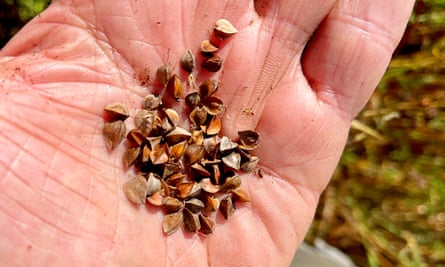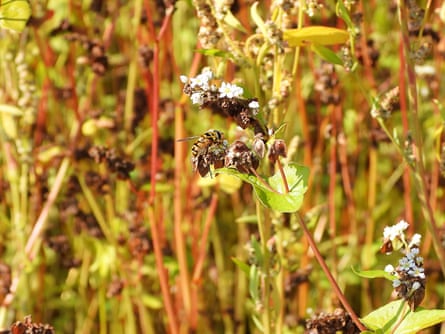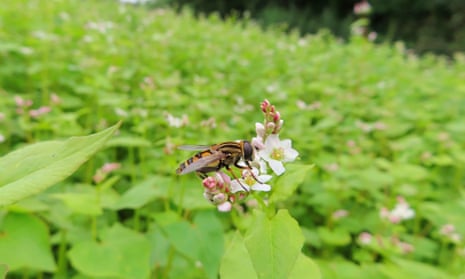Organic farmer Kees Sijbenga looks at the sea of white and pale pink blossoms before him. It is mid-July and millions of tiny buckwheat (Fagopyrum esculentum) flowers sway in the wind on the plot he is cultivating in the Dutch province of Drenthe. Sijbenga is delighted that the crop is buzzing with a multitude of insect pollinators. “I’m so happy to be growing buckwheat,” says the third-generation farmer.
Sijbenga is one of 23 farmers in the provinces of Groningen and Drenthe in the north-east of the Netherlands who are part of an ambitious, nature-inclusive agricultural project to re-establish buckwheat farming in the country.
Buckwheat flour, made from the seeds of the plant, is a key ingredient in popular Dutch foods such as pannenkoeken (thin, flat pancakes) and poffertjes (fluffy mini-pancakes), but almost all of the flour is imported. “At the beginning of the 19th century, buckwheat was the second-largest crop grown in the country, after rye,” says Peter Brul, an organic farming adviser. “It was a staple food in the country at that time.”
But with increasing access to synthetic fertilisers in the 20th century, farmers moved to more high-yield and lucrative crops. “Potatoes became the staple food, and buckwheat cultivation completely disappeared,” says Brul.

In 2019, Brul embarked on a serious effort to revive the cultivation of buckwheat in the Netherlands. The fact it is gluten free, and rich in antioxidants and high in fibre has boosted the market for it, but Brul’s efforts are also spurred by its reputation as a pollinator-friendly crop. More than half of the Netherlands’ bee species are endangered, and pollinator-friendly agriculture is crucial to their conservation.
In a pilot four years ago, a farmer in Groningen cultivated buckwheat on a one-hectare plot with Brul’s guidance. The experiment was deemed a success and now 23 farmers are producing the crop on 85 hectares scattered across Groningen and Drenthe. “What has worked well so far, is that farmers are interested and we could expand the programme,” says Brul.
Buckwheat, a summer crop, grows well in the poor, sandy soils of the eastern Netherlands. The crop has few known pests or diseases though it is extremely sensitive to frost – in 2021, each cultivated hectare yielded an average of 1,750kg of seeds (with hull), slightly lower than the target of 2,000kg, mainly due to poor weather conditions during flowering.

Buckwheat also makes for a great cover crop, enhancing the health of the soil, while its dense canopy suppresses weeds. On the same plot, farmers like Sijbenga grow a cereal, mostly wheat, in winter, followed by potatoes, sugar beets, or other vegetables in spring.
In summer, Sijbenga grows buckwheat in strips, alongside other biodiversity-friendly crops such as peas and lupines (grown for their beans). The seeds are sown in mid-May and begin to flower just over a month later. The rich nectar produced by the millions of flowers attracts huge numbers of honeybees and wild pollinators. The long flowering period – lasting until it is harvested in late August – ensures a steady supply of food for the insects, especially at a time when nectar can be scarce in agricultural areas.
Thijs Fijen, an assistant professor at Wageningen University in the Netherlands, has studied the insect diversity in these buckwheat fields. “According to our research, at any given moment during peak flowering, one hectare of the buckwheat field has an average of 6,500 wild pollinators, accounting for 51% of all pollinators present,” he says. “This includes 28 species of hoverfy, 12 species of wild bee and 13 species of butterfly.” The remaining 49% of pollinators are honeybees.
Fijen and his colleagues observed that honeybees are drawn to the buckwheat fields, leaving surrounding areas available to wild pollinators and reducing the competition they face for food. “This shows the tremendous potential of buckwheat cultivation for biodiversity conservation in agricultural landscapes,” says Fijen.
Two honeybee hives per hectare were placed close to the buckwheat plots for two to three weeks during the main flowering period (mid-July to early August). Fijen says: “Our research shows that the placement of honeybee hives for a limited period has no strong negative effects on wild pollinators. But it is required for a high yield, which ultimately keeps the farmer happy.”

Half of the buckwheat farmers are certified organic, and more are in the process of being certified. Sijbenga uses the manure from his 3,000 free-range chickens to enrich his plot.
While the buckwheat initiative has grown steadily, the journey has not been easy. Brul has had to conduct several trials and experiments, including importing different varieties of seeds to find those with a high yield, dehulling the seeds at a factory in Poland and persuading a Dutch mill to modify its equipment to process the seeds.
“Every village in the eastern part of the Netherlands had a buckwheat hulling mill 150 years ago,” says Brul. “When we started, there was not one mill left in the country. We had to go to Poland.”
Brul has also been looking at markets for hulled seeds, and for the hull itself, which can be used as a natural filling for pillows. “So far there has been enough interest from buyers that we could sell all the product,” he says. “But I’m always looking for new markets.
“You have to connect the different steps in the value chain in such a way that there is a good balance between the price the farmers need and the price consumers are ready to pay,” he adds.
Land van Ons – a citizen collective that buys degraded agricultural land on behalf of its members and restores it – is one of the partners in the buckwheat project. It has teamed up with bakeries and pasta makers to convert the buckwheat into popular products such as cookies, crackers and pastas. Franke Remerie, co-founder of Land van Ons, says: “It is important to show people and farmers that agriculture can be done in a different way.”
In its online shop, Land van Ons also sells whole, peeled buckwheat grains (to be cooked like rice), roasted buckwheat (to make a porridge called kasha, popular in eastern Europe) and finely ground buckwheat flour, as well as buckwheat hulls. “We get very positive reactions to our products,” says Remerie.
Meanwhile, Brul is pressing ahead with plans to expand production. “We hope to have twice as much buckwheat next year as we did this year,” he says. “It’s extremely important for the Netherlands to have these kinds of crops again to restore biodiversity.”
Find more age of extinction coverage here, and follow biodiversity reporters Phoebe Weston and Patrick Greenfield on Twitter for all the latest news and features
